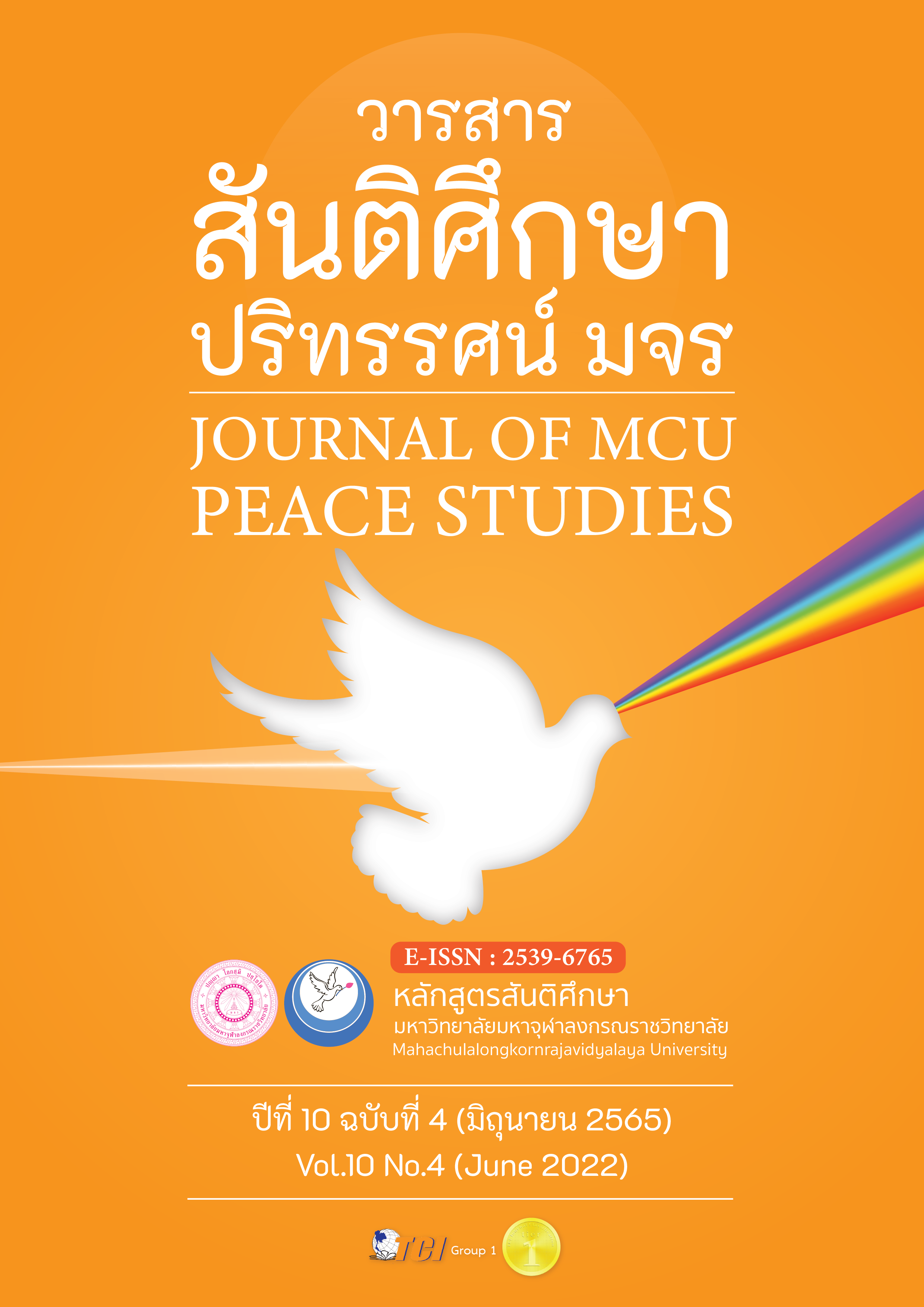การพัฒนารูปแบบการจัดการเรียนรู้โดยบูรณาการการเรียนแบบกลุ่ม และแบบการใช้ปัญหาเป็นฐาน เพื่อเสริมสร้างความสามารถในการแก้ปัญหา และผลสัมฤทธิ์ทางการเรียนคณิตศาสตร์ของนักศึกษาระดับปริญญาตรี
Main Article Content
บทคัดย่อ
บทความวิจัยนี้มีวัตถุประสงค์เพื่อ 1) พัฒนารูปแบบการจัดการเรียนรู้โดยบูรณาการ การเรียนแบบกลุ่มและแบบการใช้ปัญหาเป็นฐาน เพื่อเสริมสร้างความสามารถในการแก้ปัญหาและผลสัมฤทธิ์ทางการเรียนคณิตศาสตร์ของนักศึกษาระดับปริญญาตรี และ 2) ประเมินผลการใช้รูปแบบการจัดการเรียนรู้ การดำเนินการวิจัยเป็นการวิจัยและพัฒนา ปีการศึกษา 2562 แบ่งเป็นระยะที่ 1 การพัฒนารูปแบบการจัดการเรียนรู้
กลุ่มตัวอย่าง คือ นักศึกษา 376 คน และอาจารย์ 116 คน มหาวิทยาลัยของรัฐ ได้จากการสุ่มแบบชั้นภูมิจากส่วนภูมิภาคและกรุงเทพฯ ระยะที่ 2 การศึกษาผลการใช้รูปแบบการจัดการเรียนรู้ที่พัฒนา กลุ่มตัวอย่าง
คือ นักศึกษามหาวิทยาลัยเทคโนโลยีพระจอมเกล้าธนบุรี ได้จากการสุ่มแบบกลุ่ม จำนวน 2 กลุ่ม โดยแต่ละกลุ่มมีนักศึกษา 40 คน เครื่องมือที่ใช้ประเมินประสิทธิผลของการพัฒนารูปแบบการจัดการเรียนรู้ได้แก่ แบบทดสอบวัดผลสัมฤทธิ์ทางการเรียนและความสามารถในการแก้ปัญหาทางคณิตศาสตร์ การวิเคราะห์ข้อมูลเพื่อทดสอบสมมติฐานทางสถิติ ประกอบด้วย ค่าเฉลี่ย ส่วนเบี่ยงเบนมาตรฐาน และการวิเคราะห์ความแปรปรวนพหุคูณที่มีความแปรปรวนร่วม คือ ผลคะแนนก่อนเรียนของผลสัมฤทธิ์และความสามารถในการแก้ปัญหาทางคณิตศาสตร์
ผลการวิจัยพบว่า 1) รูปแบบการจัดการเรียนรู้ที่พัฒนาประกอบด้วย หลักการ วัตถุประสงค์
และขั้นตอนการจัดการlเรียนรู้ 6 ขั้นตอน (1) ทบทวนความรู้เดิม (2)จัดการกลุ่มเรียน (3) ศึกษาสถานการณ์
ปัญหา (4) ค้นคว้าขยายความรู้ (5) สะท้อนการแก้ปัญหา และ (6) สรุป 2) ผลการทดลองพบว่า กลุ่มที่ใช้รูปแบบการจัดการเรียนรู้ที่พัฒนามีผลสัมฤทธิ์ทางการเรียนและความสามารถในการแก้ปัญหาทางคณิตศาสตร์สูงกว่ากลุ่มที่ใช้รูปแบบการจัดการเรียนรู้เดิมอย่างมีนัยสำคัญทางสถิติที่ระดับ .05
Article Details

อนุญาตภายใต้เงื่อนไข Creative Commons Attribution-NonCommercial-NoDerivatives 4.0 International License.
ทัศนะและความคิดเห็นที่ปรากฏในบทความในวารสาร ถือเป็นความรับผิดชอบของผู้เขียนบทความนั้น และไม่ถือเป็นทัศนะและความรับผิดชอบของกองบรรณาธิการ ยินยอมว่าบทความเป็นลิขสิทธิ์ของวารสาร
เอกสารอ้างอิง
Exploring the challenges of employer-provided workforce readiness training.
Retrieved from http://www.shrm.org/Research/SurveyFinding/Articles/
Documents/BED. 09Workforce_RR.pdf.
Dick & Carey. (2019). Dick and Carey Model. Retrieved from http://www. instructional design.org/
models/dick_carey_model/
Eggen P. & Kauch, D. (2011). Strategies and models for teachers. Teaching content
and thinking skills. Boston: Pearson.
Eggen P. & Kauch, D. (2006). Strategies and models for teachers’ content and
thinking skills. Boston: Pearson.
Elizabeth, M. (2010). Creating a Community of Math Learners: Effective Strategies
for Academic Success. Pennsylvania: Penn State University Professional
Development School.
Gardner. (2018). Group Learning. Retrieved from http://www.makinglearningvisibleres
ources.org/uploads/3/4/1/9/3419723/definition_of_a_learning_group.pdf.
Higher Education Commission. (2017). Framework for Higher Education
Qualifications, Bangkok: Office of Higher Education Commission.
Johnson D. W., & Johnson R. T.(2009). An educational psychology success story: Social
interdependence theory and cooperative learning. Educational Researcher
2009. 38(5), 365-379.
Kasim, N. & Khalid, F. (2016). Choosing the Right Learning Management System (LMS)
for the Higher Education Context. A Systematic Review IJET. 11(6), 55-61.
Kathleen J, K., T.F. Mclaughim, & Vikki, F. (2001). A comparison of cooperative learning
and small group individualized instruction for math in self-contained class
for elementary students. Education Research Quarterly, 24(3), 41-56.
King, R. (2018). What are 21st century skills? Retrieved from
https://k12.thoughtful learning.com/FAQ/what-are-21st-century-skills
Ministry of Education. (2008). Basic Education Core Curriculum, 2008. Bangkok:
Teachers Council Publishing House.
Office of the Permanent Secretary, Ministry of Education. (2017). Education statistics
for the year 2016. Bangkok: Agricultural Cooperatives of Thailand Ltd.
Office of the Education Council Secretariat. (2017). National Education Plan 2017-
2036. Bangkok: Prikwan Graphic Co., Ltd.
Phanich, V. (2012). Methods for creating learning for students in the 21st Century.
Bangkok: Sodsri-Sarit Wongkee Foundation.
Piaget J. (1965), Judgment and reasoning of child. London: Poutledge and Kagen
Paul.
Sailor, W., Stowe, M. J., Turnbull, H. R. & Kleinhammer, T. P. (2007). A case for adding
a social-behavioral standard to standards-based education with school wide
positive behavior support. Remedial & Special Education, 28(6), 366-376.
Sharma, M. (2009). How important are soft skills from the recruiter’s perspective. ICFAI
Journal of Soft Skills, 3(2), 19-28.
Taylor, A. (2005). What employers look for: The skills debate and the fit with youth
perceptions. Journal of Education and Work, 18(2). 201-218.
University Council Association (Thailand). (2018). Survival Way for Thai Higher
Education (TAGB Forum 3). Retrieved from https://youtu.be/v1RjlDEVN7Y
Wongratana, C. (2017) Techniques for building research tools. Bangkok: Amon Publication.


